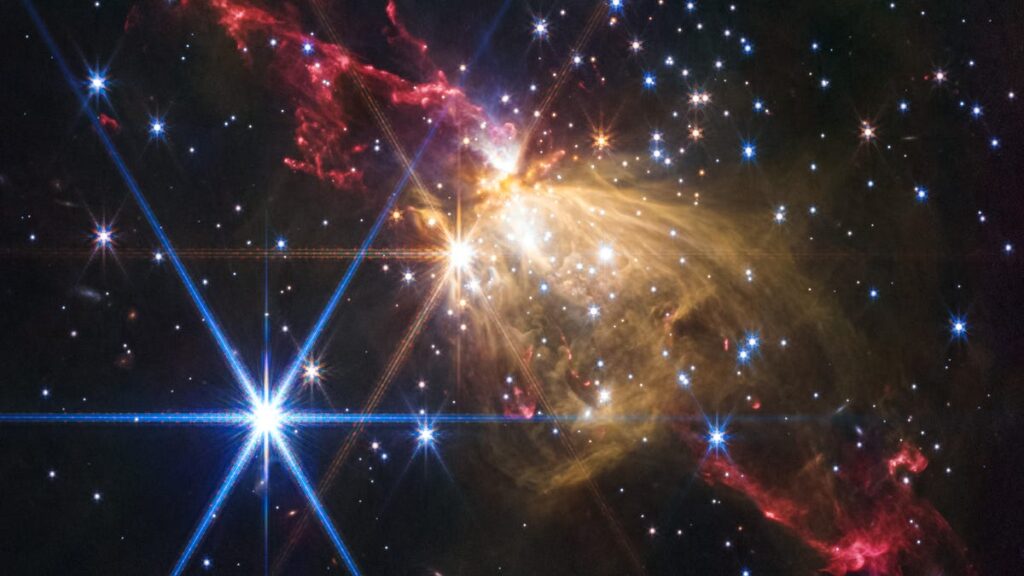As NASA described it, the stellar jet located on the outskirts of the Milky Way resembles Darth Maul’s double-bladed lightsaber from ‘Star Wars.’
NASA’s James Webb Telescope recently got a front-row seat to some incredible stellar fireworks on the outskirts of the Milky Way galaxy.
The eruption of gases from a stellar jet in a distant nebula is so big that NASA described it as a “volcanically growing monster star.”
Need another description to put the cosmic show into context? As NASA put it, Webb’s image of the stellar jet – streaking across space at hundreds of thousands of miles per hour – resembles a double-bladed dueling lightsaber like the one Darth Maul used in the “Star Wars” franchise.
Stretching across 8 light-years, the rare stellar eruption is about twice the distance between our sun and the next nearest stars, the Alpha Centauri system. The central young star, or protostar, weighing as much as 10 of our suns, is located 15,000 light-years away in the outer reaches of our galaxy.
Here’s a look at the image the Webb telescope snapped, as well as what to know about the stellar jet.
Webb telescope captures stellar jet making ‘birth announcement’
Webb got a glimpse of the stellar jet plowing into interstellar dust and gas as it sent an outflow of plasma shooting out from newly forming stars, which NASA said is akin to its “birth announcement” to the universe.
The stellar jet is located in a nebula known as Sharpless 2-284, or Sh2-284, for short.
At nearly twice the distance from the galactic center as our sun, the host proto-cluster – or group of galaxies in the early stages of formation – that’s home to the jet is on the periphery of our Milky Way galaxy. Within the cluster, a few hundred stars are still forming.
‘Spectacular outflow’ was unexpected
While hundreds of protostellar jets have been observed before, most originate from low-mass stars.
The detection of this stellar jet provides evidence that the larger the parent star, the larger the cosmic explosion, according to a team of researchers behind the find.
“We didn’t really know there was a massive star with this kind of super-jet out there before the observation,” study lead author Yu Cheng, an astronomer at the National Astronomical Observatory of Japan, said in a statement. “Such a spectacular outflow of molecular hydrogen from a massive star is rare in other regions of our galaxy.”
And where there’s one massive star, there could be others.
While other massive stars in the region may not yet be gushing quite so violently, the Atacama Large Millimeter Array in Chile found another dense stellar core that could be in an earlier stage of construction, according to the researchers.
The research has been accepted for publication in The Astrophysical Journal.
What is the James Webb Space Telescope?
The James Webb Space Telescope launched on Christmas Day 2021 aboard an Ariane 5 rocket from the European Space Agency’s Ariane Space Spaceport in French Guiana.
Webb, which then began its cosmic operations in July 2022, was designed to operate for up to 10 years. But as fortune would have it, the mission team determined the observatory should have enough propellant to allow it to operate in orbit for more than 20 years.
Billed by NASA as “the largest, most powerful and most complex telescope ever launched into space,” the James Webb Space Telescope far surpasses the abilities of its predecessor, the Hubble Space Telescope. The observatory is named for NASA’s second-ever administrator.
Orbiting the sun rather than Earth, Webb is outfitted with a gold-coated mirror more than 21 feet in diameter and powerful infrared instruments to observe the cosmos like no instrument before.
Eric Lagatta is the Space Connect reporter for the USA TODAY Network. Reach him at elagatta@gannett.com

